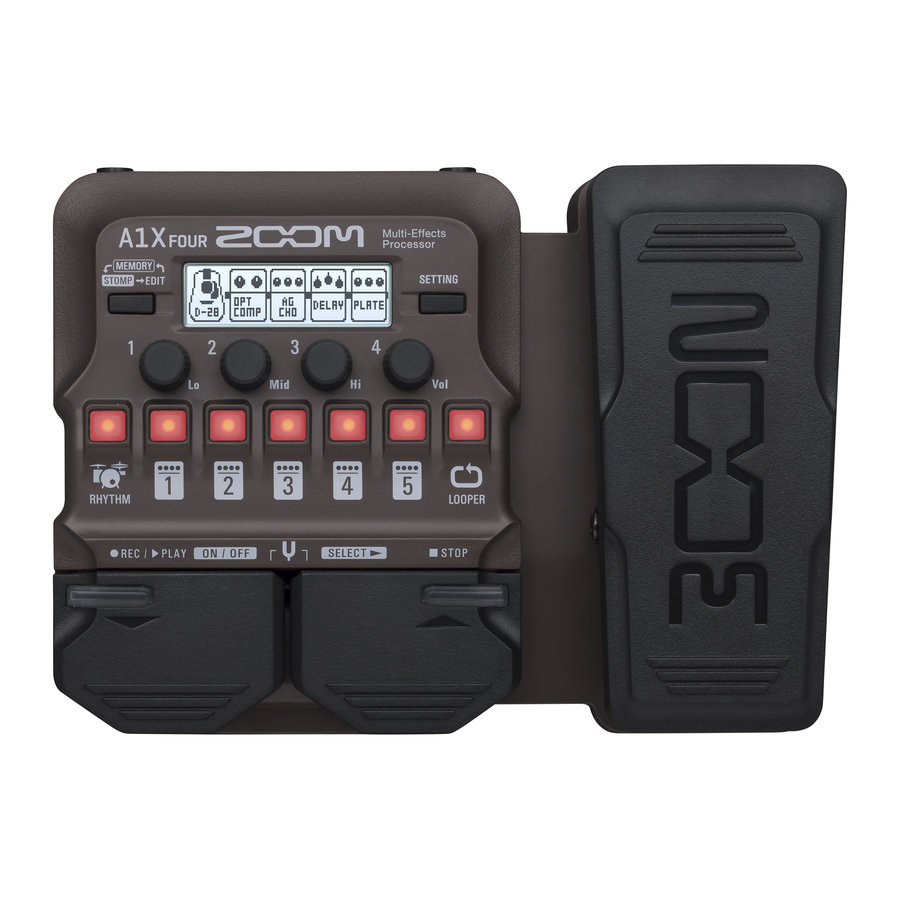
Advertisement
You must read the Usage and Safety Precautions before use.
The Operation Manual can be downloaded from the ZOOM website (www.zoom.jp/docs/a1four_
a1xfour).
This page has files in PDF and ePub formats.
The PDF file format is suitable for printing on paper and reading on a computer.
The ePub format can be read with electronic document readers and is designed for reading on
smartphones and tablets.
© 2019 ZOOM CORPORATION
Copying or reprinting this manual in part or in whole without permission is prohibited.
Product names, registered trademarks and company names in this document are the property of their respective companies.
You might need this manual in the future. Always keep it in a place where you can access it easily.
The contents of this manual and the specifications of the product could be changed without notice.
Windows® is a trademark or registered trademark of Microsoft® Corporation. Mac is a trademark or registered trademark of Apple Inc.
Multi-Effects Processor
Quick Guide
Advertisement
Table of Contents

Summary of Contents for Zoom A1 FOUR
- Page 1 Multi-Effects Processor Quick Guide You must read the Usage and Safety Precautions before use. The Operation Manual can be downloaded from the ZOOM website (www.zoom.jp/docs/a1four_ a1xfour). This page has files in PDF and ePub formats. The PDF file format is suitable for printing on paper and reading on a computer.
- Page 2 overview has numerous effects that change the sound of an instrument. Up to five can be used at the same time. Other features include a looper that can playback already recorded phrases, a rhythm machine and a tuner. In addition, by using the MAA-1, the effects can also be applied to the sounds of in- struments that are normally captured with a mic.
- Page 3 Signal flow Patch memory ④ ② ① ③ ④ ⑥ Looper Level Looper INPUT Output Output Effect volume Post OUTPUT ⑦ Tuner Rhythm ⑤ AUX IN The input instrument sound passes through effects 1 – 5 in order. Up to five effects can be selected and ordered as desired. The patch memory level is adjusted.
-
Page 4: Installing Batteries
(Mac/Windows) HINT • If a dedicated AC adapter (ZOOM AD-16) is connected, it can run on AC power. • Power for operation can also be supplied through the USB port. • By connecting an audio device, for example to the AUX IN jack, you can play along with another sound source. - Page 5 Connecting a mic Using the MAA-1, the can be enjoyed with instruments that do not have pickups, including harmonicas, violins, trumpets, saxophones and other string and brass instruments. Open the battery compartment cover on the back of the MAA-1 and insert 2 AA batteries.
- Page 6 Selecting patch memories (MEMORY mode) is preloaded with 50 patch memories. Select patch memories to use in MEMORY mode. • Patch memories These store effect on/off states and parameter setting values. Effects are saved and recalled in units of patch memories. •...
- Page 7 Turning effects on and off (STOMP mode) In STOMP mode, you can use the footswitches to turn on/off each of the effects used in the patch memory. Activate STOMP mode. • Press Select an effect. • Press The selection moves to the right. Selected Turn the effect on/off.
- Page 8 Editing effects (EDIT mode) In EDIT mode, you can change the effects used in patch memories and adjust their pa- rameters. Select a patch memory in MEMORY mode beforehand to edit it in EDIT mode. Activate EDIT mode. • Press Unit number Effect name 2, 3...
- Page 9 • Effect type Effect types cover a variety of effects, including reverb, chorus and distortion. • Category Effects are grouped into categories. When selecting effects, you can switch by cat- egory. Selecting effect types • Press This switches to the next/previous effect type. …...
-
Page 10: Using The Tuner
Using the tuner Use this to tune the connected instrument. Activate the tuner. • Press at the same time. To close the tuner, press Tune the instrument. Pitch detuning • Play the sound that you want to tune and adjust its pitch. The nearest note name and pitch detuning Nearest note will be shown on the display and by the LEDs. - Page 11 Preventing feedback The anti-feedback function can be used by selecting Anti FB. This effect can detect and cut the frequency band that is feeding back to reduce it. Activate EDIT mode. • Press Select the effect that will be used to assign Anti FB.
-
Page 12: Using Rhythms
Using rhythms You can play along with built-in rhythms. Activate the rhythm function. • Press To return to the previous mode, press Start rhythm playback. • Press To stop rhythm playback, press Setting the rhythm Turn – to change the rhythm set- tings. -
Page 13: Using The Looper
Using the looper You can record playing and create mono loop phrases that are up to 30 seconds long. Activate the looper. • Press To return to the previous mode, press Record a phrase. • Press To stop recording, press To cancel, press Play back the phrase. -
Page 14: Setting List
Setting list Press to open the SETTING screen. Press – to open the following settings, which corre- spond to the icons. 1. CHAIN (effect reordering) Effects in the current patch memory are shown in a list, and can be reordered by pressing –... -
Page 15: Specifications
120 dB Noise floor (residual noise) −97 dBu Power AC adapter (9V DC 500mA, center negative) (ZOOM AD-16) 4 AA batteries (about 18 hours continuous operation time when using alkaline batteries with the LCD backlight off) USB MIDI, USB Micro-B •... - Page 16 ZOOM CORPORATION 4-4-3 Kanda-surugadai, Chiyoda-ku, Tokyo 101-0062 Japan www.zoom.co.jp Z2I-3709-01...















Need help?
Do you have a question about the A1 FOUR and is the answer not in the manual?
Questions and answers